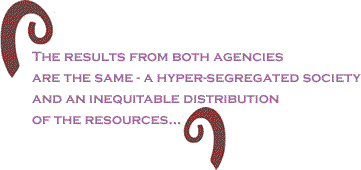
|
||||||||||||||||||||||
 |
||||||||||||||||||||||
 |
||||||||||||||||||||||
 |
||||||||||||||||||||||
 |
| The current issue is always free to everyone |
|
|
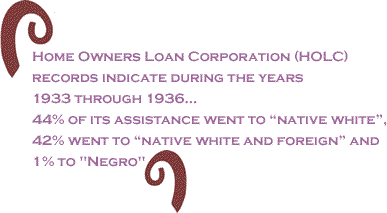 |
The Home Owners Loan Act was passed in 1933 and the Act created an emergency agency called the Home Owners Loan Corporation (HOLC). The HOLC was under the supervision of the Federal Home Loan Bank Board (FHLBB). The primary function of HOLC was to refinance mortgages that were going into foreclosure. Mortgage foreclosures were occurring at the rate of approximately 1,000 per day. By today’s standard, that number is miniscule but when viewed as a percentage of the total housing stock going into default, the numbers were approximately 45-50%. To give some context to that figure, the foreclosure rate at the end of 2007 was approaching 3%. HOLC refinanced approximately 1 million homes or close to 20% of US mortgages between 1933 and 1936. The agency reorganized the real estate finance industry. HOLC changed the financing terms that would allow:
Prior to the Great Depression, homeowners typically put a minimum of 60% down on a home, with payment terms of 3-5 years of interest only. After the term, the homeowner would refinance the loan. If the bank chose not to refinance, the homeowner would loose their down payment and property. HOLC had favorable rates as well as 216-300 months to repay the loan in full. It is alleged that some homeowners stopped paying their mortgage intentionally for the more favorable terms offered by HOLC. HOLC was started with a $200 million purchase of stock by the US Treasury Dept. The agency was authorized to issue up to $2 billion in bonds and Congress increased their limit to $3.5 billion. They could refinance homes with a market value no greater than $17,500 (the maximum loan amount was $14,000 and the average loan was less than $5,000). Most of the borrowers were on the lower end of the middle class in the $50-150 per month salary range. To reach clients in remote areas the agency was located in regional centers. Agency employees were not limited by bureaucratic constraints. They were given the latitude to treat each case differently, depending on the dynamics. They could make personal visits to prevent defaults, assist borrowers with finding employment, find tenants for rental space, file claims for public assistance, in other words they were proactive and committed to the success of the agency and as a result the default rate was approximately 20%. Not exactly perfect for servicing but on the other hand a commendable job when one considers the assets were non-performing when HOLC refinanced them. The salty story on HOLC begins like this: less than 1% of that $3.5 billion went to Black folk. HOLC’s policy was to favor single family residences outside the central cities which favored suburbia and inclined toward racial segregation based upon the premise that racially homogeneous neighborhoods were more stable and presented the lowest risk. HOLC records indicate during the years 1933 through 1936 when it was authorized by Congress to issue loans, 44% of its assistance went to “native white”, 42% went to “native white and foreign” and 1% to Negro.
The risk rating system’s overarching principle was to protect the long-term warranted value of the property. An impediment to this goal was the introduction of “undesirables” into a stable neighborhood. It became paramount to keep all neighborhoods segregated; otherwise, lenders’ investments were in peril. This perception was common and pervasive as Arthur May, former dean of American Institute of Real Estate Appraisers, stated, “homogeneity of the neighborhood and stability of property values go hand in hand and that the mere threat of Negro entry had caused a drop of 25 per cent in an all-white neighborhood in some cities”. The American Institute of Real Estate Appraisers was a consulting organization for HOLC and membership in the institute qualified an appraiser to provide services to the agency. There was a tacit agreement among all groups - lending institutions, fire insurance companies, and FHA - to block off certain areas of cities within “red lines,” and not to loan or insure within them. (U.S. National Commission on Urban Problems 1969, 101)
The “hot spots” were First (A) grade areas, coded green. These areas were in high demand during good times or bad, homogeneous, and still had room for new residential growth. Second grade of B, coded Blue had been completely developed, still good but at its peak in the life cycle of neighborhoods. Third-grade of C, colored yellow, were older neighborhoods, becoming obsolete and had expiring deed restrictions or missing restrictions (meaning Blacks could move in) and had an infiltration of a lower grade population. These areas had poorly maintained homes and often lacked homogeneity. Fourth-grade or D areas, colored red, represented those neighborhoods with lower homeownership rates, poor housing conditions, detrimental influences in a pronounced degree and undesirable population. Essentially, those areas in green represented an excellent investment, blue was a good investment, yellow was a risk and red was an extremely high risk where it was extremely difficult to find an institution to lend, hence the term redlining.
Critics of the redlining theory argue that the Federal Home Loan Bank Board (FHLLB) and the Federal Housing Administration (FHA) were two separate and distinct entities and the FHA did not use the residential security maps created by the FHLLB’s HOLC. Notwithstanding the quote from above, the two agencies’ policies were shaped by colleagues and students of the Institute for Research in Land Economics and Public Utilities. The institute, the lending and real estate industries fervently subscribed to the theory of the neighborhood lifecycle and the mortgage risk rating system. Furthermore, the results from both agencies are the same - a hyper-segregated society and an inequitable distribution of the resources in the middle and lower strata along the lines of race. To be continued. BlackCommentator.com Columnist, Lloyd Wynn was a consultant in the secondary market. Lloyd is the author of Residential Real Estate Finance: From Application Through Settlement. Click here to contact Lloyd Wynn.
|
Your comments are always welcome. e-Mail
re-print notice
If you send us an e-Mail message we may publish all or part of it, unless you tell us it is not for publication. You may also request that we withhold your name. Thank you very much for your readership. |
|
| April 17, 2008 Issue 273 |
|
| Executive Editor: Bill Fletcher, Jr. |
| Publisher: Peter Gamble |
| Est. April 5, 2002 |
| Printer Friendly Version in resizeable plain text format format |
 |
 |
 |
| |
| |





















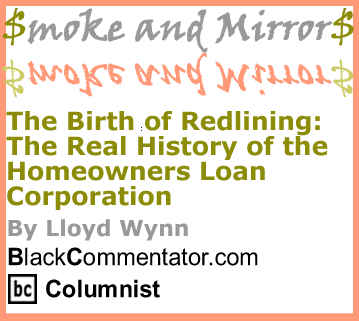

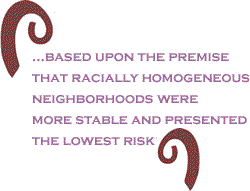 HOLC
policy was made by the Federal Home Bank Board System (FHLBB).
John H. Fahey, Chairman of FHLBB , in a speech before the
annual convention of the US Building and Loan League, Cincinnati,
OH, November, 1935, stated, “[f]or the first time a comprehensive
method of studying the risk involved in a particular mortgage
transaction had been developed by the Administration after
studying methods used in analyzing mortgage risk. These methods
have been set forth in a manual for underwriters, and some
650 staff underwriters and 1,800 fee consultants have been
trained in using them. Insurance companies and other lending
institutions have generally accepted this method as a major
contribution to the technique of mortgage lending”. The risk
rating system Mr. Fahey refers to was developed by none other
than Frederick Babcock, Asst. FHA Commissioner and FHA Chief
Economist Ernest Fisher.
HOLC
policy was made by the Federal Home Bank Board System (FHLBB).
John H. Fahey, Chairman of FHLBB , in a speech before the
annual convention of the US Building and Loan League, Cincinnati,
OH, November, 1935, stated, “[f]or the first time a comprehensive
method of studying the risk involved in a particular mortgage
transaction had been developed by the Administration after
studying methods used in analyzing mortgage risk. These methods
have been set forth in a manual for underwriters, and some
650 staff underwriters and 1,800 fee consultants have been
trained in using them. Insurance companies and other lending
institutions have generally accepted this method as a major
contribution to the technique of mortgage lending”. The risk
rating system Mr. Fahey refers to was developed by none other
than Frederick Babcock, Asst. FHA Commissioner and FHA Chief
Economist Ernest Fisher. 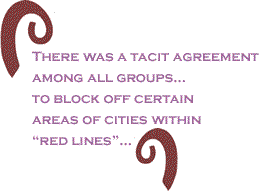 Redlining
is the practice of not lending or insuring in certain neighborhoods
based upon the racial composition. This practice was encoded
in our system of finance, real estate and insurance by the
Home Owners Loan Corporation, an agency within the Federal
Home Loan Bank Board system created by Congress. The HOLC
had a method of property evaluation to determine the suitability
of neighborhoods for investment that became the standard used
by lending institutions and other real estate professionals.
HOLC surveyed 239 cities using 4 color codes to indicate the
level of risk a particular area would present. Based upon
information gathered from bankers, appraisers, real estate
agents and governmental officials, HOLC developed Residential
Security Maps with four classifications: First (A), Second
(B), Third (C) and Fourth (D) that corresponded to color grades:
A-Green, B-Blue, C-Yellow and D-Red.
Redlining
is the practice of not lending or insuring in certain neighborhoods
based upon the racial composition. This practice was encoded
in our system of finance, real estate and insurance by the
Home Owners Loan Corporation, an agency within the Federal
Home Loan Bank Board system created by Congress. The HOLC
had a method of property evaluation to determine the suitability
of neighborhoods for investment that became the standard used
by lending institutions and other real estate professionals.
HOLC surveyed 239 cities using 4 color codes to indicate the
level of risk a particular area would present. Based upon
information gathered from bankers, appraisers, real estate
agents and governmental officials, HOLC developed Residential
Security Maps with four classifications: First (A), Second
(B), Third (C) and Fourth (D) that corresponded to color grades:
A-Green, B-Blue, C-Yellow and D-Red. 